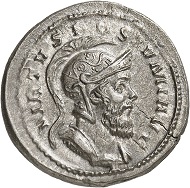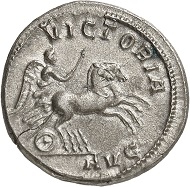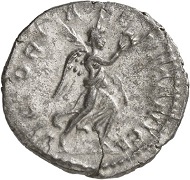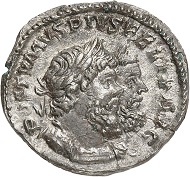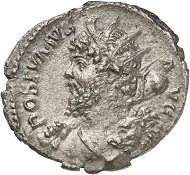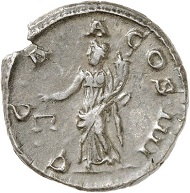Postumus – The creator of the Gallic Empire
To the inhabitants of the Roman Empire, it truly must have seemed like the beginning of the apocalypse: Plundering and murdering, a group of Alemanni went all the way to Milan, where Gallienus was finally able to repulse the attack. At the same time, the Juthungi were invading Italy. They took thousands of Roman prisoners with them, when their troops were annihilated near Augsburg. The Franks were marauding in Gaul. And the east was devastated by the Sassanians. Even the emperor was helpless: While fighting the Sassanians Valerian was taken prisoner and Gallienus did not have the necessary resources to free him.
Antoninianus, Cologne, 263. Rev. HERC DEVS-ONIENSI gable temple with Hercules. From the forthcoming Jacquier Auction 42 (16.9.16), Lot 531. Almost extremely fine. Estimate: 200 euros.
At the Rhine, people were afraid too. Gallienus had sent his son, Saloninus, even though he was still young and had to be accompanied by an advisor. When it came to a dispute after a victory over the Germanic peoples between the chaperone from Rome and the commander of the victorious troops, Marcus Cassianius Latinius Postumus, the troops proclaimed Postumus as their new emperor. Perhaps this happened in Deuso, because in numismatics Hercules Deusoniensis is only known from coins of Postumus, which is why several scholars hypothesize that it was at this location Postumus won the decisive victory over the Germanic peoples and was proclaimed the new emperor.
Denarius (billon off-metal strike from an aureus die), Cologne, fall of 261. Rev. VICTORIA AVG Victory riding biga r. From the forthcoming Jacquier Auction 42 (16.9.16), Lot 509. Extremely fine. Estimate: 8,000 euros
Antoninianus, unknown mint, 263. Rev. VICTORIA POSTVMI AVG Roma seated r., on outstretched right arm Victory. From the forthcoming Jacquier Auction 42 (16.9.2016), Lot 526. Very fine. Estimate: 4,500 euros.
At the time, usurpers were installed all over the empire. To the soldiers, the proximity to the emperor was important in order to have his attention. And it also meant gifts of money for local troops and the protection of civilians. And of course an emperor was also looked for, who was in favor of the gods and who displayed just that through a victory. That’s why it was so important to Postumus to reflect his victoriousness on his coins.
Antoninianus, Cologne, 263. Rev. VICTORI-A GERMANICA Victory r. From the forthcoming Jacquier Auction 42 (16.9.2016), Lot 533. Extremely fine. Estimate: 1,500 euros.
In this context, the victory over the Germanic peoples, which preceded Postumus’ proclamation to Emperor, was particularly recognized.
Double sestertius, Cologne, 261. Rev. HERCVLI MAGVSANO Hercules r. From the forthcoming Jacquier Auction 42 (16.9.2016), Lot 657. Very fine. Estimate: 350 euros.
It didn’t take long for Postumus to be recognized in Germania, Gaul, Raetia, Hispania, and Britannia, which is why he was able to concentrate on securing the Rhine border. Coins featuring the image of Hercules Magusanus, whose cult was wildly spread on the Lower Rhine, point to this theory. Perhaps Xanten was at risk in the years of 260/1 and was defended personally by the emperor.
Antoninianus, Cologne, 261. Rev. LAETITIA AVG Galley l. From the forthcoming Jacquier Auction 42 (16.9.2016), Lot 512. Almost extremely fine. Estimate: 100 euros.
For defense, Postumus had built a powerful Rhine fleet, which is commonly deduced from coins like this one. It features a brand new type of vessel.
Imitation of Postumus’ coinage. Antoninianus, mint II(?). Rev. HERC – PACIFERO. Hercules l. From the forthcoming Jacquier Auction 42 (16.9.2016), Lot 822. Extremely fine / Almost extremely fine. Estimate: 50 euros.
Examining Postumus’ coins quickly shows that Hercules was his favorite subject and that he appears especially frequently on coins.
Quinarius, Cologne, 266. Bust of Postumus and head of Hercules, both r. From the forthcoming Jacquier Auction 42 (16.9.2016), Lot 562. Almost extremely fine. Estimate: 3,000 euros.
There are coin pictures which are totally contrary to the usual image patterns. For example, Hercules accompanying the emperor on the obverse.
Medallion, Cologne, end of 267 / beginning of 268. Rev. HERCVLI IN-VICTO Hercules r., restraining the Cretan Bull. From the forthcoming Jacquier Auction 42 (16.9.2016), Lot 571. Almost extremely fine. Estimate: 10,000 euros.
Several special emissions feature the labors of Hercules. This medallion, a bronze off-metal strike from a die, which was made for a quadruple aureus in the end of 276 / the beginning of 268, is dedicated to the fight against the Cretan Bull.
Denarius, Cologne, beginning of 268. Rev. HERCVLI ER-VMANTHIO Hercules, carrying the Erymanthian Boar on his shoulders; in front of him Eurystheus hiding in a pithos. From the forthcoming Jacquier Auction 42 (16.9.2016), Lot 582. Extremely fine. Estimate: 8,000 euros.
In 268, on the occasion of the 4th consulate of Postumus and as a kind of an advanced issuance to mark the 10th anniversary of his reign as emperor, an interesting series illustrating several labors of Hercules was produced. The dies of the aurei were not only used to strike gold coins, but also to strike silver denarii. One of them features Hercules, who has just caught the Erymanthian Boar and is about to throw the animal onto the pathetically whining Eurystheus, who is hiding in a pithos.
Denarius, Cologne, beginning of 268. Rev. HERCVLI PISAEO Hercules swinging a hoe, before him, a fountain vessel as a symbol of the Alpheus. From the forthcoming Jacquier Auction 42 (16.9.2016), Lot 583. Almost extremely fine. Estimate: 7,000 euros.
Another presents Hercules at a less heroic labor: He cleans out the completely dirty Augean Stables. Doing that, he redirects the Alpheius, which is symbolized by a fountain vessel. Hercules swings the hoe in order to create a new riverbed.
Antoninianus, Cologne, beginning of 268. Rev. HERCVLI INVICTO Hercules, to his feet Amazonian Queen Hippolyta. From the forthcoming Jacquier Auction 42 (16.9.2016), Lot 585. Extremely fine. Estimate: 4,000 euros.
Amazing images can also be found on simple antoniniani. For example on this antoninianus, which was minted around the same time as the denarii. It displays the slain Amazonian Queen Hippolyta, from whom Hercules, by the order of Eurystheus, took the girdle.
Why does Hercules appear so often on the coins of Postumus? Two coins might be able to help find answers.
Antoninianus, Cologne, 267. Rev. VIRTVTI AV-GVSTI Hercules r. From the forthcoming Jacquier Auction 42 (16.9.2016), Lot 567. Extremely fine. Estimate: 400 euros.
Firstly, there is this 267 antoninianus. It combines the demigod Hercules with the inscription VIRTVTI AVGVSTI. But to translate virtus with virtue simply falls too short. Virtus also contains the Latin word vir (= man). And this word made a Roman rather think of a quote, which we know from many movies: “A man’s got to do what a man’s got to do.” Virtus was really understood as the responsible performance of duties, the veneration of tradition, the willingness to achieve the will of the gods.
Hercules at the crossroads. Girolamo di Benvenuto, 1st half of the 16th century. Source: Wikipedia.
And this is what Hercules symbolized. Already in antiquity the poets knew Hercules at the crossroads: Indecisive of which path of life to take, the young Hercules came to a crossroad, where two women were waiting for him. One of them, elaborately spruced up, promised him an easy life full of joy. Hercules asked her for her name. For friends happiness, for fiends vice, she answered him. The other woman was dressed simply and told Hercules that the gods had put work before reward. Her name was Virtue and her path was hard but honorable. Hercules, of course, decided to take the difficult but honorable path. And Postumus, by depicting Hercules, claimed this path for himself.
Denarius, Cologne, beginning of 268. Bust of Postumus and head of Hercules l. Rev. CASTOR The dioscur Castor r., holding his horse by its bridle. From the forthcoming Jacquier Auction 42 (16.9.2016), Lot 588. Good very fine. Estimate: 3,000 euros.
This identification repeatedly appears on coins. On the obverse we see Postumus accompanied by Hercules. The reverse displays Castor, who was known to the Greeks as one of the dioscuri. Castor was mortal, Pollux immortal. Thus, Postumus associated himself as a mortal brother of an immortal being, hence Hercules.
Antoninianus, Cologne, 1st half of 268. Bust of Postumus, heroically nude, with lion skin and shouldered club l. Rev. HERCVLI ROMANO AVG bow, club, quiver. From the forthcoming Jacquier Auction 42 (16.9.2016), Lot 572. Extremely fine. Estimate: 3,000 euros.
Which is why Postumus appears wearing Hercules’ attire on coins.
Sestertius, Cologne, fall of 260. Rev. HERCVLI DEVSONIENSI Bust of Hercules displaying Postumus’ facial features. From the forthcoming Jacquier Auction 42 (16.9.2016), Lot 632. Almost very fine. Estimate: 600 euros.
Or Hercules is displayed featuring Postumus’ facial features.
Striking of Aureolus in the name of Postumus in Milan. Antoninianus, 267/8. Rev. VIRTVS A-EQVIT Romulus to the r. From the forthcoming Jacquier Auction 42 (16.9.2016), Lot 613. Good very fine. Estimate: 500 euros.
And indeed, Postumus did not only have to fight against invading tribes, but also against the Emperor Gallienus. In 266 or 267 Gallienus layed siege on a city, perhaps Trier, and was injured during the battles. He ordered his commander Aureolus to continue the fight, but he in turn decided to follow Postumus – approximately around the end of 267 although the exact date is not clear –, which is why an emission was minted for Postumus in Milan. Gallienus took his army back to Milan, where Aureolus had declared himself emperor. During the siege Gallienus was murdered and the title of emperor was transferred to Claudius Gothicus, who for his part had defeated Aureolus.
Antoninianus, Cologne, late 268. Rev. C C A A COS IIII (= Colonia Claudia Augusta Agrippinensium) Moneta. From the forthcoming Jacquier Auction 42 (16.9.2016), Lot 598. Very fine. Estimate: 1,500 euros.
At approximately the same time, in late 268, this coin was struck. Here, the first time the city of Cologne as COL(onia) CL(audia) AGRIP(pinensium) is mentioned. Since the middle of the year of 268, the administration of the Gallic Empire was forced to sharply reduce the silver content of the metal used to produce antoniniani. It is probably during this time, that the Cologne mint was moved to Trier, only to be moved back after a short while in order to not provide any more unnecessary attention to the city’s unrest. It is most likely that this striking can be associated with these events.
Antoninianus. Cologne, beginning of 269. Rev. PM TR – P X COS V P P Emperor. From the forthcoming Jacquier Auction 42 (16.9.2016), Lot 602. Extremely fine. Estimate: 1,000 euros.
In any case, it wasn’t only in Cologne that the last coin was minted in the beginning of 269, …
Antoninianus, Trier, beginning of 269. Rev. PACATOR ORBIS Sol to the r. From the forthcoming Jacquier Auction 42 (16.9.2016), Lot 609. Extremely fine. Estimate: 500 euros.
… but also the last Postumus coin ever in Trier. Its inscription Pacator Orbis, bringer of peace to the world, was probably based on the hope, …
Laelianus. Antoninianus, Cologne. From the forthcoming Jacquier Auction 42 (16.9.2016), Lot 701. Extremely fine. Estimate: 1,800 euros.
… of quickly defeating the usurpation of Ulpius Cornelius Laelianus in Mainz, which did in fact happen.
Marius. Antoninianus, Trier. From the forthcoming Jacquier Auction 42 (16.9.2016), Lot 704. Almost extremely fine. Estimate: 800 euros.
But what exactly took place is quite unclear. Apparently, Postumus refused to let Mainz be plundered, which is why he was murdered by his soldiers. Marius became the new emperor, but only until the spring of 269 – and here also, the details are not completely clear – when he was murdered as well.
The Gallic Empire existed for a few more years. In 274 Aurelian was able to bring it under his control. Aurelian did not execute the last Gallic Emperor, Tetricus, and he did not declare damnatio memoriae against the Gallic usurpers, which has to be interpreted as a gesture of recognition.
All the above coins will be on offer at the Jacquier Auction 42, which will be conducted on September 16, 2016. Please view the complete online auction catalog here.
And the relevant CoinsWeekly preview can be read here.










